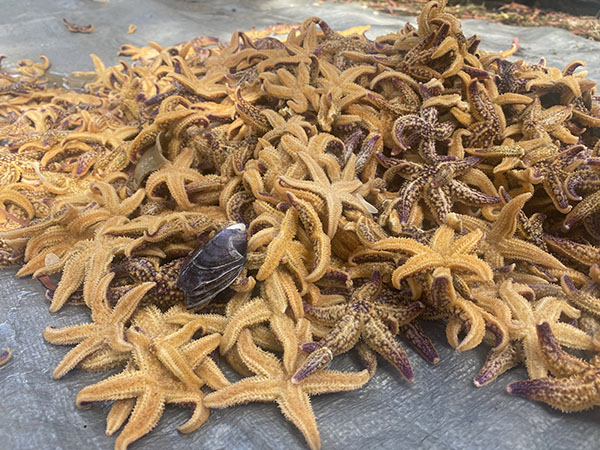Northern Pacific Seastar
12 June 2024
Reports of a significant die-off of the Northern Pacific seastar, a highly invasive marine pest, have been confirmed at Carrum in south-eastern Port Phillip Bay.
The increased number of seastars is currently present at Carrum but it has also been reported at Seaford, Frankston, Edithvale and Mount Martha.
Agriculture Victoria Principal Officer Invasive Marine Species, Dr Richard Safford-Bell, said the Northern Pacific seastar was first detected in Port Phillip Bay in 1995, and by 2000 a significant population of the seastar had established.
‘It is a widespread and well-established marine pest in Port Phillip Bay and cannot be eradicated. There have been dead seastars reported in the area since February 2024, but numbers have increased significantly over the last few months.
‘We would like to highlight the great work of Earthcare St Kilda and the Port Phillip EcoCentre in organising removal events of the Northern Pacific seastar, with over 60,000 removed since February.’
Earthcare St Kilda welcomes volunteers to assist in seastar removal events.
The key features of the Northern Pacific seastar are 5-pointed arms with upturned tips and yellow and purple markings. It is an opportunistic predator that consumes a large variety of prey. In high densities, it can have severe effects on wild and cultured shellfish populations, and on native biodiversity.
Bay users should be aware that marine pests can spread easily to new areas of Victoria through movement of recreational equipment such as boats, kayaks and canoes, and fishing equipment.
Dr Stafford-Bell urged people using marine equipment in the affected area to follow the Check, Clean, Dry method to reduce the risk of spreading marine pests to other marine areas.
‘This is particularly important for people moving any equipment used in Port Phillip Bay to other areas,’ Dr Stafford-Bell said.
Good marine equipment hygiene means:
- Check any equipment and vessels that have been in marine waters for pests.
- Clean the equipment in freshwater.
- Dry the equipment before moving to a new marine location.
He added that Northern Pacific seastars are not poisonous or dangerous to people or domestic animals and asked that beachgoers finding Northern Pacific seastars washed up on the shoreline not to return them to the water.

Northern Pacific seastars collected by volunteers.
For more information:
https://earthcarestkilda.org.au/get-involved/northern-pacific-seastar-removal/
Quote attributable to Dr Richard Stafford-Bell, Principal Officer Invasive Marine Species, Department of Energy, Environment and Climate Action
‘All users of the marine environment have a role to play in preventing the spread of marine pests. Marine pests can be microscopic in size at early growth stages, so people may not even realise they’re transporting them on their boat or equipment. To help stop their spread, practice good vessel hygiene through the “Check, Clean, Dry” method.’
Quote attributable to Earthcare St Kilda Marine Conservation Project Lead Richard Pensak
‘Earthcare St Kilda volunteers have collected over 60,000 individuals since February. While we may never be able to eliminate this destructive species, we are working to minimise the risk that these animals will be discovered outside of Port Phillip Bay. Removal of this invasive species is our way of safeguarding our native local biodiversity.’
Quote attributable to Neil Blake OAM, Port Phillip Baykeeper, Port Phillip EcoCentre
‘These pest seastars are the cane toads of the Bay! We need all hands on deck to stop them decimating the Bay food chain. Port Phillip EcoCentre has trained community Rapid Response Teams to respond to Northern Pacific seastar aggregations. Augmenting regular monthly collections by Earthcare St Kilda, Rapid Response volunteers recently collected over 10,000 Northern Pacific seastars in one weekend; showing the power of community engagement in marine pest biosecurity.’
Media contact: Steve Pogonowski
Phone: 0447 273 461